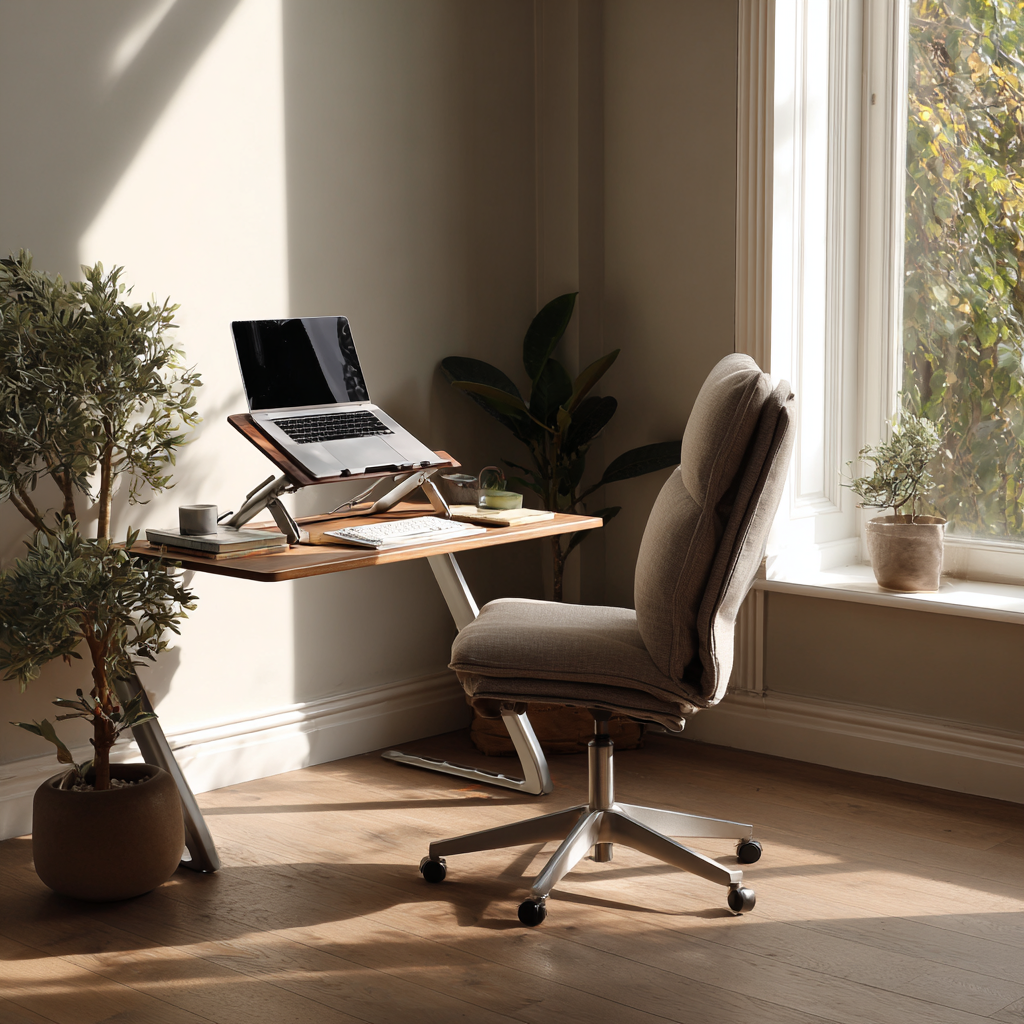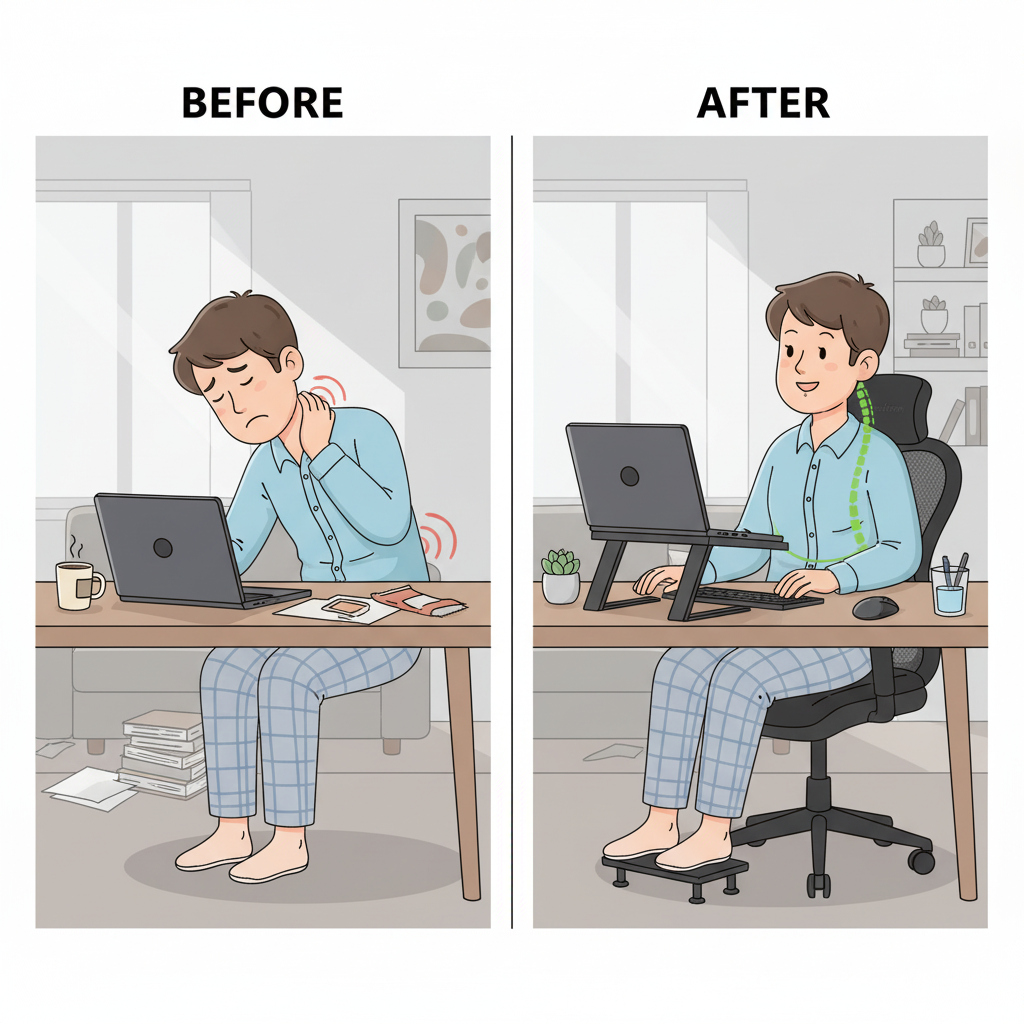
The Simple Desk Setup That Improves Focus
The workday often begins with energy and clarity—tasks are outlined, priorities are set, and momentum feels strong. Yet by mid-afternoon, many professionals experience a familiar decline: concentration wanes, productivity slows, and routine responsibilities demand more effort than they should.
While factors such as workload and digital distractions play a role, one of the most overlooked contributors to this loss of focus is the physical environment itself. A poorly designed desk setup can lead to subtle but persistent discomfort—strained posture, awkward screen angles, or insufficient support—that gradually drains mental energy.
Research underscores this connection. According to the American Productivity Audit, U.S. companies lose an estimated $225.8 billion annually due to reduced productivity linked to health-related factors, including musculoskeletal discomfort from poor ergonomics. In other words, even minor workplace strain translates into significant performance costs over time.
The encouraging reality is that focus can be preserved, and even enhanced, with a workspace designed to support both body and mind. Strategic ergonomic adjustments not only reduce physical strain but also free up cognitive resources, allowing you to stay engaged and productive throughout the day.
In this article, we will explore how to create a simple desk setup for focus, with practical recommendations that apply across a variety of work environments—whether you are working from home, adapting to a hybrid schedule, or making the most of a compact space. Each adjustment is straightforward, evidence-based, and designed to help you sustain concentration and improve overall performance.

How Discomfort Steals Your Focus
Discomfort at your desk is more than a nuisance—it is a hidden drain on concentration and productivity. A chair set too low, a monitor positioned just slightly off-center, or wrists angled awkwardly at the keyboard may seem like minor inconveniences, but over the course of a workday they accumulate into constant, low-level strain.
This strain is not merely physical. When your body is uncomfortable, your brain is forced to divide its attention between the task at hand and the signals of tension coming from your muscles and joints. Even subtle neck or back pain pulls cognitive resources away from focused work, creating a steady pattern of distraction.
The research supports this connection. The National Institute for Occupational Safety and Health (NIOSH) has documented that musculoskeletal discomfort contributes directly to reduced work performance and increased fatigue. In practical terms, this means that poor ergonomics can slow progress, shorten attention spans, and contribute to early burnout in the workday.
Practical Adjustments to Restore Focus
Fortunately, a few targeted adjustments can significantly reduce this source of distraction:
- Position Your Monitor at Eye Level - The top third of your screen should align with your natural eye line. For laptop users, elevating the screen with a stand prevents the downward tilt that strains the neck.
- Maintain a Neutral Sitting Posture - Keep your feet flat on the floor (or on a footrest), with hips and knees at roughly 90 degrees. This stable base reduces stress on your lower back.
- Align Your Keyboard and Mouse - Wrists should remain straight, with elbows relaxed and close to your body to avoid unnecessary strain.
👉 Ergonomic Tip: If you often work from a laptop, consider using a stand to bring the screen to eye level. A simple adjustment like this helps reduce neck and shoulder tension, making it easier to maintain focus. The Serenform Elevate Laptop Stand is one option designed for this purpose.

A Simple Setup for Any Space
A well-designed desk setup is not limited to those with a dedicated home office. In reality, many professionals are working from kitchen tables, makeshift corners, or shared spaces that were never intended for full workdays. The encouraging news is that improving focus does not require an elaborate office or a large budget. With a few strategic adjustments, even the smallest or most temporary workspace can support concentration and comfort.
Space-Smart Ergonomics
- Elevate Your Laptop - Working directly from a low screen encourages a forward head posture that leads to strain. Elevating your laptop - whether with a stack of books or a slim, adjustable stand - helps align the screen at eye level and immediately improves posture.
- Incorporate External Tools - Adding a compact external keyboard and mouse allows for a more natural typing position, reducing tension in the wrists and shoulders while making your workspace more adaptable.
- Declutter for Mental Clarity - Visual clutter competes for attention and reduces working memory, making it more difficult to concentrate on tasks. Keeping your desk surface clean and intentional enhances mental focus.
Minimalist Hacks
- Repurpose Everyday Items – A sturdy shoebox or stack of firm books can serve as a makeshift footrest, keeping your posture balanced if your chair sits too high.
- Define the Space with Lighting – A small desk lamp or task light can create a sense of boundary between “work” and “home,” even when you are sharing a table or corner space. Good lighting also reduces eye strain and helps maintain alertness.
| Adjustment | Why It Matters | Easy Implementation |
|---|---|---|
| Laptop elevation | Prevents neck and shoulder strain | Use a stand or books |
| External keyboard + mouse | Reduces wrist and arm tension | Compact wireless set |
| Declutter workspace | Frees mental bandwidth, improves focus | Remove non-essential items |
| Foot support | Keeps posture balanced, reduces leg fatigue | Shoebox, books, or compact footrest |
| Task lighting | Defines workspace, reduces eye strain | Small desk lamp or daylight bulb |
👉 Ergonomic Tip: For those who often work in small or flexible spaces, a compact footrest can make a noticeable difference in comfort and focus. The Serenform Axis Footrest is one example designed to support posture without taking up extra room.

The Mind-Body Connection at Your Desk
Focus is not determined by physical setup alone—it is equally shaped by how your environment supports mental clarity and well-being. A desk that reduces physical strain does more than protect posture; it also frees the brain from the constant, low-level distractions caused by discomfort. The result is more cognitive energy available for deep, sustained work.
Ergonomics and Mental Energy
- Posture and Stress: Research has consistently shown that posture influences psychological state. Poor posture is linked to increased fatigue and stress, while sitting upright has been associated with improved mood and greater cognitive performance.
- The Role of Light: Lighting also plays a critical role. Natural light exposure has been shown to increase productivity by up to 15% among office workers, according to the World Green Building Council. Adequate lighting reduces eye strain and helps regulate energy levels throughout the day.
- Environment and Focus: A cluttered or overstimulating environment forces the brain to divide attention, making it harder to remain fully engaged in a task. A streamlined, intentional workspace encourages calm and focus.
Practical Adjustments to Enhance Clarity
- Prioritize Natural Light: Whenever possible, position your desk near a window. If natural light is limited, consider a daylight-balanced lamp to mimic its benefits.
- Stay Hydrated: Keeping water within reach prevents the dips in energy and concentration linked to dehydration.
-
Create Breathing Room: Limit the number of items on your desk surface to only what you need for work. A clear workspace allows for a clearer state of mind.
Tools and Accessories That Support Focus
Even with the right habits in place, certain tools can make a significant difference in maintaining focus throughout the day. The best ergonomic desk setups not only prevent discomfort but actively support productivity by promoting healthier posture and reducing unnecessary strain.
Accessories Worth Considering
-
Monitor Stands & Laptop Risers – Help align the screen with your natural eye level, reducing neck and shoulder tension.
-
Footrests – Encourage balanced posture and reduce fatigue in the lower body during long work sessions.
-
Ergonomic Chairs – Provide structured lumbar support, promoting a natural spinal position.
-
Keyboard Trays – Keep wrists neutral and elbows relaxed, reducing the risk of repetitive strain.
Why These Tools Matter
When discomfort is minimized, the brain no longer has to “split focus” between the work task and the signals of strain coming from the body. Over time, this translates into greater concentration, longer periods of deep work, and measurable improvements in productivity.
👉 Ergonomic Tip: If you spend long hours working from a laptop, a riser or stand can help prevent neck strain by lifting your screen to eye height. The Serenform Elevate Laptop Stand is one example designed for this purpose. Similarly, adding a compact footrest, such as the Serenform Axis Footrest, can support proper posture and reduce fatigue in smaller workspaces.

Small Adjustments, Big Results
Improving focus at work does not require a full office renovation or an extensive investment in new equipment. In many cases, it comes down to a series of small, intentional changes—raising your screen to eye level, supporting your posture with the right seating or footrest, and reducing visual distractions on your desk. These adjustments may seem minor, but their impact compounds over the course of the workday.
The result is tangible: greater energy in the afternoon, less physical fatigue, and the ability to sustain deeper concentration for longer periods of time. By aligning your environment with your body’s natural needs, you free your mind to concentrate on the work that matters most.
The most effective part of this approach is its accessibility. Many improvements can be implemented immediately, with little more than a thoughtful rearrangement of your workspace or the addition of one or two ergonomic tools. Taken together, these refinements create a desk setup that supports both productivity and well-being.
👉 Next Step: If you are ready to explore ergonomic solutions designed specifically for people who work from home, Serenform Ergonomics offers products that make these small but important adjustments easy to put into practice.


